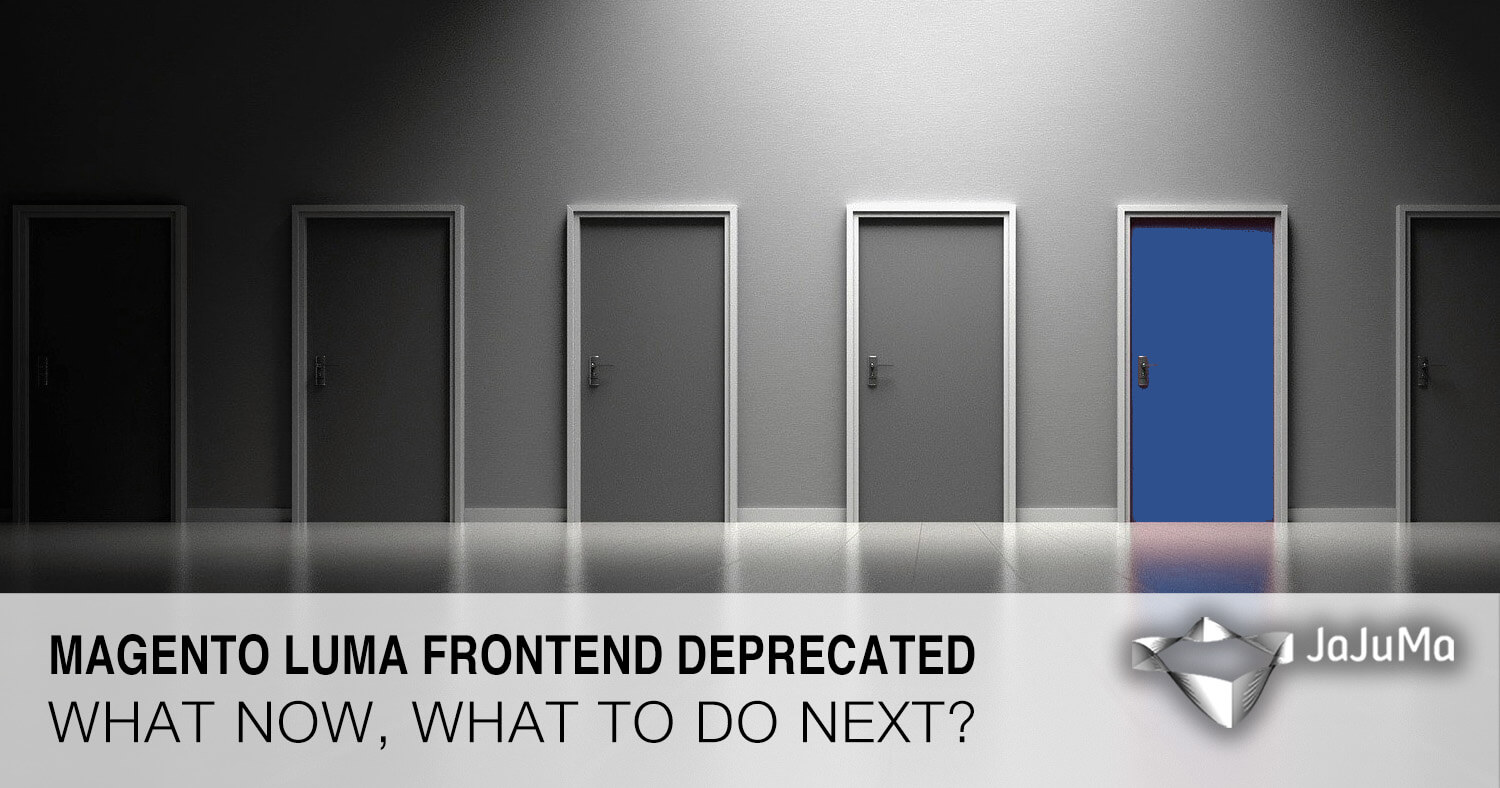It's not really new information, the default Magento frontend "Luma Theme" will be discontinued by Adobe
This was communicated some time ago, but now confirmed again in the January update of the Magento Open Source Community Alliance.
That it will happen sooner or later was also foreseeable. The Luma theme was, to put it mildly, not a success story from the beginning.


In addition, one had to expect this step also due to the strategic realignment at Adobe with a focus primarily on enterprise-level customers.
The end of the Luma theme is therefore not a big surprise. Also in general it is nothing unusual that software products reach the end of their life cycle - On the contrary.
However, Adobe's roadmap also shows that there will be no direct successor to the Luma theme.
Against this background, the questions "What's next?", "What options and alternatives are there?" naturally arise for every online merchant who is currently using the Luma theme. Alternatives are there?" and also for online merchants who are considering Magento as a future online store the question arises with which frontend they can operate their Magento store can be operated.
Magento 2 - The Current Situation
But before we go into the question of what the consequences of the Luma theme end-of-life are and the frontend for Magento will continue, a few words about the current situation around Magento in general.
Most recently, we had reported on this in our blog post Yet Another View On The Future Of Magento. Meanwhile there is the very readable "January 2022" Update by Magento Open Source Community Alliance (MOSCA)
Probably the most important statement from this update: "Magento 2 is in fantastic shape, thanks to a lot of effort put in by both Adobe and the community. The platform has never been more flexible and stable, filling all merchants’ needs." We can only agree with this and also with the otherwise consistently positive message of the update.
No question, it would be even more positive if there was a stronger interest and commitment to Magento Open Source on the part of Adobe and in particular to continue to position Magento as a solution for small and medium-sized retailers, both in terms of product and marketing. After all, Magento's roots are right here and it was this broad user base that was the foundation on which Magento could become what it is - arguably the best e-commerce solution in the world that can meet the needs of small merchants as well as enterprise-level requirements.
But that's the way it is, the decision on the part of Adobe to address only enterprise customers with "Adobe Commerce" and to rely more and more on dovetailing with other Adobe services has been made.
However, this is not a reason to worry, thanks to the MOSCA initiative and the unique Magento community, Magento Open Source will continue to be a first-class choice also for small and medium-sized e-commerce businesses.
The Luma Theme Will Be Deprecated And Will Not Be Developed Further - What Does That Mean?
According to Adobe, the Luma theme has had its day and will no longer be developed. A concrete date for the "end" of the Luma Theme does not exist yet, but it should at least not come in the short term. The "sundowning" of the Luma theme is probably to be expected sometime after the "PWA Studio", whose current proof-of-concept implementation is the "Venia Storefront", has reached a final state.
However, no further development also means: There will probably only be necessary security patches, maintenance updates, etc. for the Luma theme, but no significant new features and no more innovations.
In other words, the Luma theme will never achieve adequate performance and contemporary PageSpeed or Core Web Vitals values.
What Does The End Of The Luma Theme Mean For New Magento Projects?
For new projects that are now planned with Magento, the Luma theme can no longer be recommended in good conscience.
No matter if it is a completely new e-commerce project with Magento, a migration from another cart software or platform, or just a re-design or optimization of an existing Magento store. In these cases, using the Luma theme would be an investment that would be obsolete by the time of implementation. A contemporary performance and user experience is not achievable with the Luma theme with reasonable effort anyway.
For new projects, you should urgently choose an alternative to avoid having to redo everything in maybe 1 or 2 years.
What Does The End Of The Luma Theme Mean For Magento Stores Currently Using The Luma Theme?
No need to panic! For Magento stores that currently use the Luma theme or a third-party theme based on Luma as their frontend, there is nothing to stop them from continuing to use it for some time. At least as long as it works satisfactorily and well.
However, it is still advisable for these online stores to deal with the topic of the frontend as early as possible, to look at alternatives, and to consider migration in the longer-term planning.
But you should also be aware of this: Every investment in further optimization of the existing Luma theme frontend is an investment in a dying technology. An investment in a frontend that will most likely be replaced by a new one in the not too distant future. So instead of putting even bigger budgets into a Luma frontend now, it might make more sense to migrate to an alternative earlier than absolutely necessary and use this budget directly for the optimization of a new frontend.
What Are The Alternatives And Successors For The Luma Theme?
There will be no direct successor for the Luma theme from Adobe.
But it is probably not least due to the shortcomings of the Luma theme that both Adobe and the Magento community have been looking for alternatives for some time. With the result that there are already several alternatives today, with fundamentally different approaches and solutions.
This is certainly not the worst development for the Magento ecosystem because a diverse offering will ultimately also lead to competition and thus more innovation. We briefly present the available alternatives below:
PWA Frontends For Magento, PWA Studio, Vue, ScandiPWA etc.
For several years now, "Progressive Web Applications" (PWA) or more precisely "Headless Frontends" have been propagated as the future for e-commerce frontends. Several PWA frontends are now available for Magento. Besides "PWA Studio" from Adobe, the designated successor frontend for the Luma theme, VueStorefront, ScandiPWA and others.
We at JaJuMa could never really do much with the hype around PWAs. Whenever we looked at one of these solutions, we were not really convinced. The general architecture of these headless solutions, the underlying technology, the performance that couldn't fulfill the promises in the end, and especially the complexity associated with PWAs during the implementation... None of these PWA frontends could meet our requirements to provide our customers with solutions that meet our quality and budget needs.
We are glad that we and our customers have been spared the negative experiences of other agencies with the implementation of PWA frontends.
It may be that there are use cases for which a PWA is the right solution (e.g., possibly in enterprise-level application scenarios). However, it has become apparent that our assessment of the PWA topic was not entirely wrong. The maturity level of the available PWA solutions often still leaves a lot to be desired, which makes extensive in-house developments necessary. A really good performance is difficult to achieve with PWAs (contrary to the usual promises), a corresponding project team is required to handle the complexity associated with PWAs, and so on.
A PWA solution is therefore in our view only worth considering for online merchants who have a specific requirement that can be better solved with PWAs (Whatever that is...) and want to invest the appropriate budget for such a project.
Hyvä Themes - The Next-Generation Magento Frontend
No direct successor for the Luma Theme from Adobe... PWA alternatives that could not convince in practice so far...
What else is there as a viable alternative? Hyvä Themes!
Hyvä Themes is the frontend for Magento as you could wish for. Performant, easy to customize, without the problems of the Luma theme and without the complexity and other drawbacks of PWAs.
If you look for disadvantages of the Hyvä Theme, you will first of all come across the license costs, which are with 1000,- € much higher than for the free Luma theme or even other Luma based themes from third parties that only cost a fraction.
The bottom line is that the advantages of the Hyvä theme clearly outweigh the disadvantages and it convinces all along the line.
Why the Hyvä theme is so good, why it is the 1st choice as a frontend for Magento and why it is worth every cent of the license costs we have written here in more detail:
Top 10 Reasons for Hyvä Theme.
As an early adopter, we have gained a lot of experience with the Hyvä theme. In the process, it has been proven in practice that the Hyvä theme keeps its promises and also meets the highest demands.
More info about our previous work with Hyvä Themes can be found here:
Online-Shop with Magento 2 & Hyvä Theme
Other And Further Alternatives Magento Frontends
It remains to be seen if there will be more alternatives until or with the actual end of the Luma theme. For more competition between the different approaches, this would certainly not be the worst for the Magento ecosystem.
For example, there is already the "Breeze" frontend from SwissUpLabs which follows a similar approach as the Hyvä theme. In our opinion, however, less sophisticated and well thought out than Hyvä Themes.
Conclusion
There is a lot going on in the Magento world!
This is not a cause for concern. Even if Adobe withdraws from marketing Magento Open Source and focuses primarily on its enterprise solution Adobe Commerce and the integration of other Adobe services. Everything points to the fact that Magento in the open-source variant will continue to be the leading e-commerce solution in the future, especially for small and medium-sized online retailers.
Hyvä Themes is the best example of the strength and innovation of the Magento community. After Adobe failed to create an adequate frontend for Magento, Willem Wigman, the creator of Hyvä Themes, stepped into the breach and fills this gap.
Und das auf beeindruckende Art und Weise wie wir finden. We are convinced Hyvä Themes will be the leading frontend for Magento in the next years.
You can't go far wrong by choosing Magento with Hyvä Themes as your frontend!



